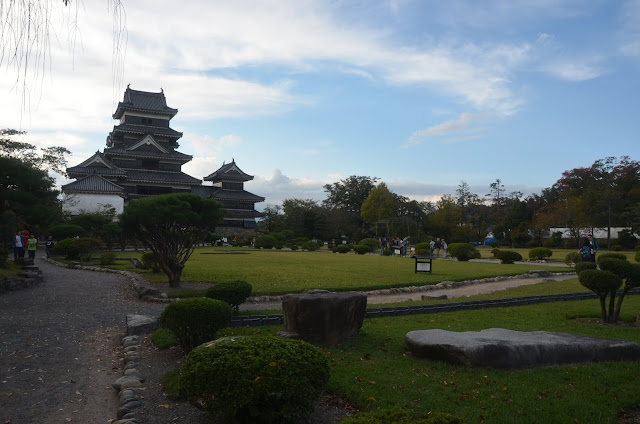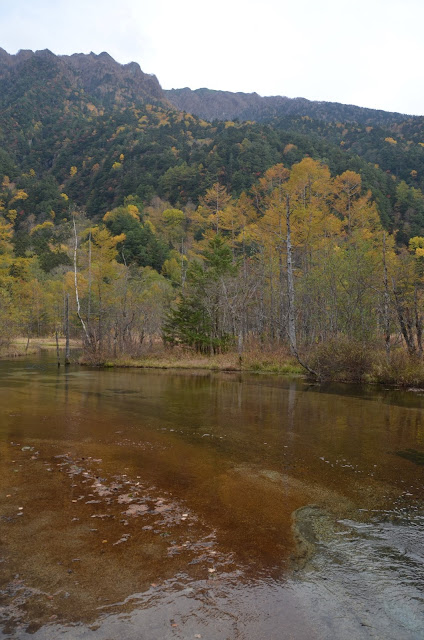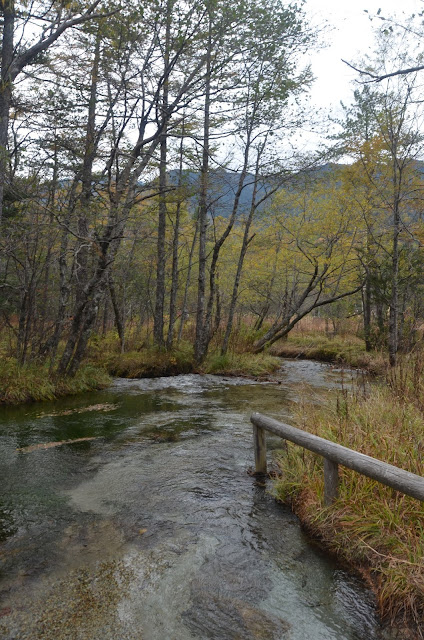Matsumoto Castle (松本城), originally called Fukashi Castle, is one of the three original castles in Japan and is in Matsumoto, Nagano, Japan. It is the oldest five-story donjon tower in Japan. The castle is surrounded by a small moat and the grounds are not as large as some other castles in Japan but it is very beautiful with the dark black siding that gives it the nickname crow castle (like in Okayama). The castle was home to 23 generations (including 6 families) that were successors of the Matsumoto Clan including the Ishikawa, Ogasawara, Todo Senior, Matsudaira, Hotta, Mizuno and Toda Junior families.
 |
| Matsumoto Castle (松本城) |
 |
| Matsumoto Castle (松本城) |
 |
| Matsumoto Castle (松本城) |
 |
| Matsumoto Castle (松本城) |
The moon observatory scaffold is a room that has three sides open to the air with sliding doors but it was under construction.
 |
| Matsumoto Castle (松本城) |
 |
| Matsumoto Castle (松本城) |
The inner grounds of the castle only have one building remaining but previously most of the grass area in the photo below would have been various building. Residences were built after the completion of the tower and was the lords house and the administrative center. It was the center of political life in the area until it burned down in the 12th year of the Kyoho Era. Residence moved to the second wing and was the center of politics until the end of the Edo Era. This is now a historical park.
 |
| Matsumoto Castle (松本城) |
 |
| Matsumoto Castle (松本城) |
 |
| Matsumoto Castle (松本城) |
 |
| Matsumoto Castle (松本城) |
 |
| Matsumoto Castle (松本城) |
 |
| Matsumoto Castle (松本城) |
 |
| Matsumoto Castle (松本城) |
 |
| Matsumoto Castle (松本城) |
 |
| Matsumoto Castle (松本城) |
 |
| Matsumoto Castle (松本城) |
 |
| Matsumoto Castle (松本城) |
 |
| Matsumoto Castle (松本城) |
 |
| Matsumoto Castle (松本城) |
 |
| Matsumoto Castle (松本城) |
 |
| Matsumoto Castle (松本城) |
 |
| Matsumoto Castle (松本城) |
Our real purpose for staying in Matsumoto was actually access to Kamikochi (上高地). Kamikochi is a nearby mountain valley within Chūbu-Sangaku National Park. It has been preserved nicely and the forest is actually old mixed woods. It is a famous area for hiking in the Japanese alps, however what we found is that there are not any good day hikes that you can really do from Matsumoto. Some might be attempted if you get a really early start from accommodation in Kamikochi but the added time to get there by train makes it too tight of a squeeze to fit in one of the alpine hikes which are more like a weekend to a week trip. Word of warning though. Pack food! They do have some sit down restaurants but nothing where you can get good food like a bento box to hike around with.
I was sad to miss out on the opportunity to hike up high into the alps of Japan. The photos of them look gorgeous and Kamikochi is a perfect place to start one of these treks. Kamikochi itself as the valley is incredibly beautiful. Visiting in the fall meant we got to see some colour in the leaves.
There are walking trails all throughout Kamikochi that make a nice loop around the valley and various sights it has. One of the first iconic places we passed was Kappa Bridge (河童橋). The bridge in this location has been rebuilt seven times and was originally a drawbridge and then a simple suspension bridge with no handrails.
The birding in Kamikochi was amazing. I was really hoping for the chance to see a Narcissus flycatcher but sadly this was missed. Birds were a constant along the walking trails although most often they were high in the tops of ancient trees and very difficult to spot. There were Coal Tits, Willow Tits, Japanese Woodpeckers, Japanese Pygmy Woodpeckers, Eurasian Wrens, Gray Wagtails, Brown Dippers, Mallard Ducks, Oriental Turtle Doves and Eurasian Nuthatches.
 |
| Kamikochi (上高地) |
 |
| Kamikochi (上高地) |
 |
| Kamikochi (上高地) |
 |
| Kappa Bridge (河童橋) |
 |
| View from Kappa Bridge (河童橋) |
 |
| View from Kappa Bridge (河童橋) |
 |
| View from Kappa Bridge (河童橋) |
 |
| Eurasian Wren |
 |
| Kamikochi (上高地) |
 |
| Kamikochi (上高地) |
 |
| Kamikochi (上高地) |
 |
| Kamikochi (上高地) |
 |
| Kamikochi (上高地) |
 |
| Kamikochi (上高地) |
 |
| Kamikochi (上高地) |
 |
| Kamikochi (上高地) |
 |
| Kamikochi (上高地) |
 |
| Kamikochi (上高地) |
 |
| Kamikochi (上高地) |
 |
| Kamikochi (上高地) |
 |
| Kamikochi (上高地) |
 |
| Kamikochi (上高地) |
 |
| Kamikochi (上高地) |
 |
| Kamikochi (上高地) |
 |
| Kamikochi (上高地) |
 |
| Kamikochi (上高地) |
 |
| Kamikochi (上高地) |
 |
| Kamikochi (上高地) |
 |
| Kamikochi (上高地) |
 |
| Kamikochi (上高地) |
 |
| Kamikochi (上高地) |
 |
| Kamikochi (上高地) |
 |
| Myojin-ike Pond |
 |
| Myojin-ike Pond |
 |
| Myojin-ike Pond |
 |
| Myojin-ike Pond |
 |
| Myojin-ike Pond |
 |
| Mallard Duck at Myojin-ike Pond |
 |
| Myojin-ike Pond |
 |
| Myojin-ike Pond |
 |
| Myojin-ike Pond |
 |
| Myojin-ike Pond |
 |
| Kamikochi (上高地) |
 |
| Myojin-bashi Bridge, Kamikochi (上高地) |
 |
| Kamikochi (上高地) |
 |
| Kamikochi (上高地) |
 |
| Kamikochi (上高地) |
 |
| Kamikochi (上高地) |
 |
| Kamikochi (上高地) |
 |
| Kamikochi (上高地) |
 |
| Kamikochi (上高地) |
 |
| Kamikochi (上高地) |
 |
| Kamikochi (上高地) |
 |
| Kamikochi (上高地) |
 |
| Kamikochi (上高地) |
 |
| Kamikochi (上高地) |
 |
| Tashiro-ike Pond, Kamikochi |
 |
| Tashiro-ike Pond, Kamikochi |
 |
| Tashiro-ike Pond, Kamikochi |
 |
| Kamikochi (上高地) |
 |
| Kamikochi (上高地) |
 |
| Kamikochi (上高地) |
 |
| Kamikochi (上高地) |
 |
| Kamikochi (上高地) |
 |
| Kamikochi (上高地) |
 |
| Kamikochi (上高地) |
 |
| Taisho pond (大正池) |
 |
| Taisho pond (大正池) |
 |
| Taisho pond (大正池) |
 |
| Taisho pond (大正池) |
 |
| Taisho pond (大正池) |

No comments:
Post a Comment